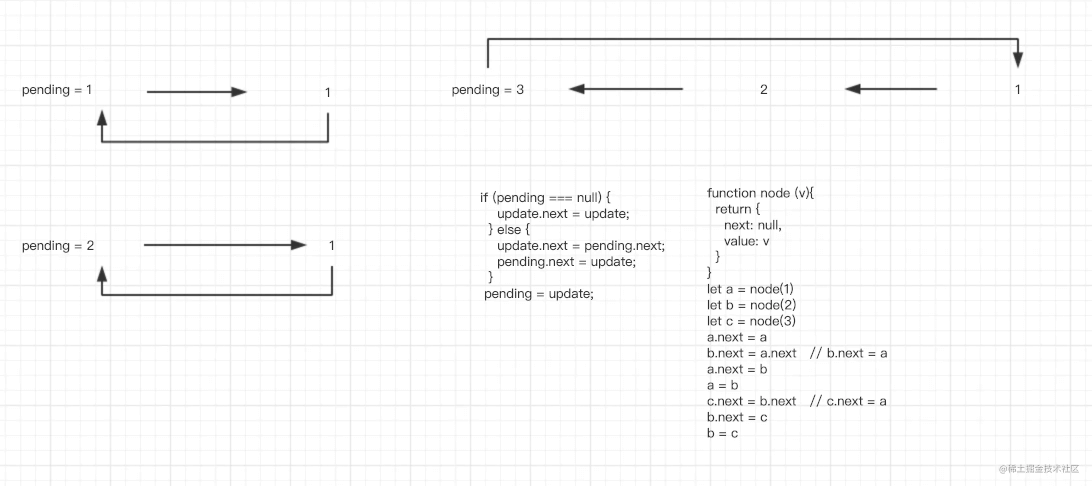1、State 属性
React 把组件看成是一个状态机(State Machines)。通过与用户的交互,实现不同状态,然后渲染 UI,让用户界面和数据保持一致。
React 里,只需更新组件的 state,然后根据新的 state 重新渲染用户界面(不要操作 DOM)。
import React from 'react ';
import ReactDom from 'react-dom';
class Student extends React.Component{
constructor() {
super();
this.state={
name:'花少北'
}
}
render() {
this.state.name='老番茄';
return <h4>{this.state.name}</h4>
}
}
ReactDOM.render(<Student/>,document.getElementById('root'))在React中,一个组件中要读取当前状态需要访问 this.state, 而 state 是可以被修改的,但是,要更新数据直接给 this.state 赋值是不可行的,必须要使用 setState()
this.setState() {
name:'某幻'
}(1)setState 不会立刻改变React组件中state的值.
(2)setState 通过触发一次组件的更新来引发重绘.
(3)多次 setState 函数调用产生的效果会合并。
2、Props 属性
react中说的单向数据流值说的就是props,根据这一特点它还有一个作用:组件之间的通信。props本身是不可变的,但是有一种情形它貌似可变,即是将父组件的state作为子组件的props,当父组件的state改变,子组件的props也跟着改变,其实它仍旧遵循了这一定律:props是不可更改的。
props属性的特点
1.每个组件对象都会有props(properties的简写)属性
2.组件标签的所有属性都保存在props中
3.内部读取某个属性值:this.props.propertyName
4.作用:通过标签属性从组件外 向组件内传递数据(只读 read only)
5.对props中的属性值进行类型限制和必要性限制
类组件:
import React from 'react ';
import ReactDom from 'react-dom';
// 函数组件
function Student(props){
return <p>{props.name} {props.address}</p>
}
const Stu={
name:'某幻',
address:'青岛'
}
ReactDOM.render(<Student{...Stu} ></Student>,document.getElementById('root'))函数组件:
import React from 'react ';
import ReactDom from 'react-dom';
class Student extends React.Component{
render() {
return(
<p>{this.props.name} {this.props.address}</p>
)
}
}
const Stu={
name:'某幻',
address:'青岛'
}
ReactDOM.render(<Student{...Stu} ></Student>,document.getElementById('root'))props 属性 和 state 属性的区别
- props中的数据都是外界传递过来的;
- state中的数据都是组件私有的;(通过Ajax获取回来的数据,一般都是私有数据)
- props中的数据都是只读的,不能重新赋值;
- state中的数据,都是可读可写的;
- 子组件只能通过props传递数据;
3、Refs 属性
定义:组件内的标签可以定义ref属性类标识自己,有点类似与JS中的id
React文档中再三强调,请不要过度使用refs,所以当我们可以用dom原生对象解决时,尽量不要使用refs 依照之前的写法,首先是给出类组件和函数组件中refs的写法
ref 的三种形式
(1)字符串形式
【官方不推荐】
class App extends React.Component{
changeInput = ()=>{
const {input} = this.refs
}
render() {
return (
<div>
<input type="text" placeholder={"please input your value"} onBlur={this.changeInput} ref={"input"}/>
</div>
)
}
}(2)函数回调形式
class App extends React.Component{
changeInput = ()=>{
console.log(this.inputRef);
}
render() {
return (
<div>
<input type="text" placeholder={"please input your value"} onBlur={this.changeInput} ref={(el)=>{this.inputRef = el}}/>
</div>
)
}
}(3)createRef 创建 ref 容器
【目前官方最推荐的一种】
class App extends React.Component{
inputRef = React.createRef()
changeInput = ()=>{
console.log(this.inputRef.current);
}
render() {
return (
<div>
<input type="text" placeholder={"please input your value"} onBlur={this.changeInput} ref={this.inputRef}/>
</div>
)
}
}函数组件的写法
function App(){
const inputRef = useRef("")
return (
<div>
<input type="text" placeholder={"please input your value"} ref={inputRef}/>
</div>
)
}到此这篇关于深入理解React 三大核心属性 的文章就介绍到这了,更多相关React 核心属性内容请搜索好代码网以前的文章或继续浏览下面的相关文章希望大家以后多多支持好代码网!



